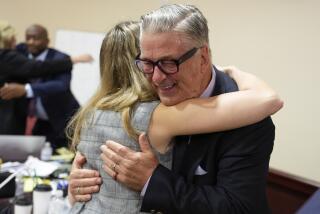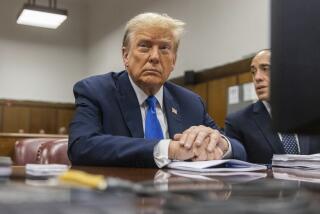1st Stage of Jury Selection Ends; Bid for Delay Rejected : Simpson case: Judge calls progress ‘spectacular.’ Prosecution had sought a change in the trial schedule.
Superior Court Judge Lance A. Ito effectively ended Wednesday the first phase of jury selection in the O.J. Simpson murder trial and rejected a prosecution motion that would have postponed some juror questioning until after a hearing on scientific evidence.
Ito called the progress in questioning prospective jurors about possible hardships “spectacular,” and announced Wednesday morning that enough jury candidates had emerged to allow him to end the face-to-face interviews that he has used to determine who could serve on the panel. Instead, he moved to excuse prospective jurors who indicated in written questionnaires that they might have difficulty being considered.
That left 257 selected since Monday and 53 more who will be chosen today. They will face more grueling questioning about possible biases and exposure to press coverage when the next phase of jury selection begins early next month. At the end of that process, Ito hopes to have 12 jurors and eight alternates who can impartially weigh the evidence and come to verdicts.
Meanwhile, Ito rejected an effort by prosecutors to alter the trial schedule to shield prospective jurors from publicity, particularly about an upcoming hearing in which DNA evidence will be vigorously contested by both sides.
Wednesday’s court session highlighted a day of diverse developments in the Simpson case. In addition to the proceedings in Ito’s courtroom:
* KNBC-TV released a letter to Ito in which the station defended its efforts to report developments accurately and pledged to correct reports if they turn out to be inaccurate. On the air, the station acknowledged that its sources have now raised questions about KNBC stories stating that blood on a sock found in Simpson’s bedroom matched the DNA of Nicole Brown Simpson.
* Police Chief Willie L. Williams, appearing on the “Today” show, defended his department’s handling of the case and said leaks about the investigation were coming from a variety of sources, not just police officers. The LAPD has launched an internal investigation to uncover the sources of some news reports, but Simpson’s lawyers have asked the state attorney general to open an inquiry as well.
* Court officials indicated that the grand jury investigation of Simpson’s close friend Al (A.C.) Cowlings appeared to be drawing to a close. Two people who saw Cowlings and Simpson on the freeway and reported them to police--touching off a low-speed pursuit broadcast live around the world--testified before the grand jury Wednesday, as did Cathy Randa, Simpson’s longtime assistant.
Randa, who had already testified twice before the grand jury, and the other witnesses were the last scheduled to testify in that investigation but prosecutors will continue to sift through the evidence. Cowlings is under investigation to determine whether he was aiding Simpson’s flight from justice June 17, as authorities maintain, or whether he was merely trying to stop his lifelong friend from committing suicide, as his lawyer has stated.
As the Simpson murder case moves toward trial, attention this week has focused on the first phase of the complex process of picking a jury. Many factors complicate that task, most of them related to the enormous publicity that erupted within hours of discovery of the bodies of Nicole Simpson and Ronald Lyle Goldman on June 13.
Simpson has proclaimed his innocence and has insisted on moving his case to trial as quickly as possible.
The speed with which the case has moved has created a potentially difficult problem when it comes to picking a jury while holding what is expected to be a lengthy and hotly contested hearing on the admissibility of DNA evidence. Ito and the attorneys spent much of this week trying to decide which prospective jurors should be excused because of work or personal hardships.
On Wednesday, that process was very brief because Ito agreed to let any prospective juror who had claimed a hardship on a written questionnaire leave without further questions. Only one possible juror was questioned because she said she had discovered a possible conflict after answering the questions.
She was excused after meeting with Ito and the attorneys. Simpson attended that session, appearing relaxed. He briefly chatted again with reporters who sat near him in the intimate confines of the interview room.
“I’ve got to watch what I say to you guys,” Simpson said to the reporters. “If I say it, I know I’ll read it tomorrow morning.”
Then, underscoring his own vow to remain silent, Simpson recited a kind of name, rank and serial number: “O.J. Simpson, 47, No. 32,” he said.
“I hope to see you again under different circumstances,” Simpson added before leaving.
Under the trial schedule that Ito outlined earlier this month, a full panel of jurors and alternates was to be selected before the DNA hearing and then sent home and asked not to pay attention to the media coverage while the hearing is under way.
On Wednesday, however, Deputy Dist. Atty. William Hodgman appealed to Ito’s “sense of order and common sense” in urging that the final phase of jury selection be postponed until after the DNA hearing so that all prospective jurors could be questioned about their exposure to that debate.
Because coverage is pervasive, prosecutors fear that jurors would inevitably be exposed to the publicity and that some would have to be excused. If enough jurors were tainted, a mistrial might be declared and the entire process begun again, even before a single witness had testified, prosecutors warned.
“In the name of common sense, and in the name of . . . reducing the potential for mistrial, I ask that the court seriously consider this proposal,” said Hodgman, who warned that even conscientious jurors would hear about the case at work or in the supermarket. “We’ll have our trial. We won’t have downtime. Mr. Simpson already is getting his speedy trial, so to speak. Right now, what we have to be concerned about is whether both sides will get a fair trial.”
But Simpson’s lawyers argued that the prosecution’s proposed alternative--suspending the final phase of jury selection until after the DNA hearing--would slow the process. Moreover, they insisted that jurors can be selected and then told to avoid coverage, admonitions that Simpson’s lawyers said they expect jurors to take seriously.
“We have a lot of confidence in jurors, your honor,” said Johnnie L. Cochran Jr., one of Simpson’s lead attorneys. “If your Honor makes an order for a juror not to do certain things, I think you’re going to find that jurors will traditionally follow the court’s ruling. . . . Whether you bring them back on the 12th or whatever day, I think you’re going to find that they’ve complied with your order.”
Ito, although conceding that jurors will have to be re-interviewed when they return after the DNA hearing, said that process could be handled in a single day and would not be too burdensome. Changing the rest of the schedule, he said, would inconvenience all 310 prospective jurors, a move he did not want to make.
“I think it would be a more impractical thing to disrupt that process . . . than to disrupt the courtroom proceeding here,” Ito said.
The 310 remaining members of the jury panel are racially diverse--about 30% are people of color, according to statistics kept by the judge--and have been asked to report back in groups to the Downtown Criminal Courts Building beginning Oct. 12. All but one group has filled out questionnaires probing the prospective jurors’ views on an array of topics. Ito and attorneys for both sides will follow up with oral questioning when they return.
The lawyers and their jury consultants will have most of this week and next to review the completed questionnaires. They received the first batch Wednesday, along with instructions from Ito that the forms are not to be disseminated and must be shredded before any of them are thrown away. Ito will retain his own set of the questionnaires and plans to make copies public as jurors are impaneled.
The process of individually questioning potential jurors about their biases and exposure to press reports could last several weeks. Once it is complete, the two sides will move to the hearing on DNA evidence. Prosecutors are expected to seek the admission of blood and hair samples taken from the crime scene, as well as from Simpson’s home and car.
The DNA tests will probably form an important bulwark of the prosecution’s case because they could establish whether Simpson was at the crime scene and whether the suspect tracked blood back to Simpson’s home. If so, that could be powerful circumstantial evidence against him, but if the DNA tests suggest another person’s blood, the tests could work just as powerfully in his favor.
Simpson’s legal team is prepared to mount an aggressive challenge to the DNA results on several fronts--suggesting that the blood samples were improperly collected and questioning the statistical significance of any purported DNA match.
Some of the DNA tests have been completed while others are under way. According to sources, results of tests performed on blood droplets found at the scene show that they genetically match Simpson’s blood. Preliminary DNA tests of a bloody glove found at Simpson’s mansion suggest the blood of both victims but were inconclusive for Simpson’s blood.
In its controversial report last week, KNBC-TV said DNA tests of a sock discovered in Simpson’s bedroom matched Nicole Simpson’s blood, another potentially damaging piece of evidence against the football star. But sources have told The Times that only conventional blood analysis has been run so far on the sock. Although that test tends to suggest Nicole Simpson as a possible source of the blood, it is not nearly as conclusive as a DNA test, sources said.
Still, investigators plan to test the sock using DNA analysis, sources said, so there may still be DNA results offered on it at some point. The latest batch of samples in the Simpson case were forwarded to a laboratory for DNA testing this week, according to sources.
The KNBC reports, which stated that two DNA tests on the sock had been completed and that the results had been returned, were contested last week by the rare combination of attorneys for both sides and by Ito. Although the station at first stood behind its story, in a report aired on the 11 p.m. news Tuesday, KNBC acknowledged that there may have been mistakes.
“KNBC has been told by some sources that information given to us and reported by us is--in some respect--factually incorrect,” the report said. “But none will detail for us specifically what is wrong with our report.”
KNBC said it had accurately reported the information provided by its sources and that it relied on people who had previously provided solid information. “Now, for the first time, some of them are changing portions of their stories,” KNBC said. “The real truth may only come out in court.”
THE SIMPSON CASE. A daily update. Trial Highlights
A look at some of the key events in the murder trial of O.J. Simpson on Wednesday:
* Summary: Having identified 310 potential jurors who may be willing to serve on the case, Superior Court Judge Lance A. Ito announced that he was ending the process of individually questioning prospective panelists about hardships. Starting Oct. 12, the remaining prospective jurors will begin returning to be asked about biases that may make it impossible for some of them to serve.
* Court action: Ito denied a prosecution request to delay jury selection until after a hearing on the admissibility of DNA evidence.
* Outside the courtroom: KNBC-TV, which has come under fire for a report about DNA tests, released a letter to Ito defending its reporting techniques. In a report Tuesday, however, the station acknowledged that its sources now say the station erred last week.
More to Read
Sign up for Essential California
The most important California stories and recommendations in your inbox every morning.
You may occasionally receive promotional content from the Los Angeles Times.











